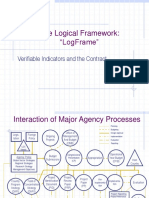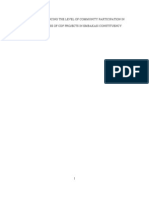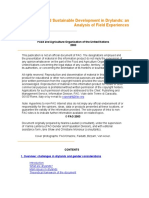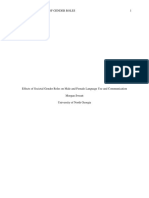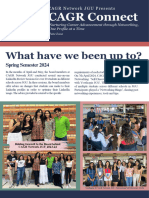Framworks For Gender Analysis
Uploaded by
Titus MasilaFramworks For Gender Analysis
Uploaded by
Titus Masila1- Harvard Analytical Framework
Objectives To demonstrate that there is an economic rationale for investing in women as well as men.
To assist planners design more efficient projects.
To emphasize importance of good information as basis for efficient/effective projects.
To map the work of women and men in the community and highlight differences.
Features 1. Socio Economic Activity profile (looks at who does what, where, when and for how long?)
2. Access and control profile (looks at who has access to and control over resources and benefits)
3. Analysis of influencing factors (looks at other factors that affect the gender differentiations, past and present
influences, and opportunities and constraints)
4. Contains a checklist of key questions to ask at each stage
Best Suited For project design rather than programme or policy planning.
As a gender neutral entry point when working with those who might be resistant to looking at gender relations.
For collecting baseline data.
Strengths Practical and hands on.
Collects and organises info about gender division of labour - it makes women’s work visible.
Distinguishes between access to and control over resources.
Useful for projects at micro level.
Can be easily adapted to a range of settings.
Relatively non-threatening as it is focussed on collecting facts.
Limitations Needs to be used with another tool to allow idea of strategic gender needs to be identified.
Focus on projects not programmes.
Focus on efficiency not effectiveness - does not provide guidance on how to change gender inequalities.
Top down planning tool that excludes men and woman’s own analysis of their situations.
Can be carried out in a non-participatory way.
Tends to over simplify, based on tick box approach
Ignores other inequalities such as race, class and ethnicity.
Emphasizes separation of activities based on sex or age - ignores connections and cooperative relations.
2- Gender Planning Framework (Caroline Moser)
Objectives Focus on strategic gender needs and concentrates on gender inequalities and how to address these at programme and policy
level.
Features 1. Gender roles identification - focus on triple roles of women (productive, reproductive and community)
2. Gender needs assessment (practical and strategic needs)
Best Suited For planning at all levels from policies to projects.
In conjunction with the Harvard Framework
Strengths Assumes planning exists to challenge unequal gender relations and support women’s empowerment.
Makes ALL work visible through concept of triple roles.
Alerts planners to interrelationships of triple roles.
Recognizes institutional and political resistance to transforming gender relations.
Distinguishes between practical gender needs (those that relate to women’s daily life) and strategic gender needs
(those that potentially transform the current situation)
Limitations Framework does not mention other inequalities like class, race and ethnicity.
Framework is static and does not examine change over time.
Looks at separate, rather than inter-related activities of women and men.
Strict division of practical and strategic needs not always helpful in practise.
Strategic needs of men not addressed.
3- Social Relations Framework (Naila Kabeer IDS)
Objectives To analyze gender inequalities in the distribution of resources, responsibilities and power.
To analyze relationships between people, their relationships to resources and activities and how these are reworked
through institutions.
To emphasize human well being as the final goal of development.
Features 1. Development is increasing human wellbeing (survival, security autonomy)
2. Social relationship analysis. The way people are positioned in relation to tangible and intangible resources.
3. Institutional analysis Key institutions; state, market, legal, family/kinship. Aspects of institutions; rules, activities,
resources, people, power.
4. Institutional gender policy analysis
5. Analysis of underlying and structural causes and the effects of these.
Best Suited Can be used across all modalities of development delivery from project to policy planning. Can be used at local, national,
regional and international levels.
Strengths Presents a broader picture of poverty.
Conceptualizes gender as central to development thinking not an add-on.
Used at different levels for planning and policy development.
Links micro and macro analysis.
Centers analysis on institutions and highlights their political aspects.
Highlights interactions between inequalities - race, class, and ethnicity.
Dynamic - works to uncover processes of impoverishment and empowerment.
Limitations Can appear to be complicated.
Since it looks at all inequalities - it can subsume gender into other analytical categories.
Can overlook the potential for people to effect change.
May give an overwhelming impression of large institutions.
4- Women’s Empowerment Framework
Objectives To achieve women’s empowerment by enabling women to achieve equal control over factors of production and participate
equally in the development process.
Features Framework introduces five hierarchical levels of equality (the higher you go the more empowered you are)
1. Control
2. Participation
3. Conscientisation
4. Access
5. Welfare
Framework distinguishes between women’s issues and concerns as well as identifying three levels of recognition of
women’s issues in project design.
Best Suited Useful across micro (project) and macro (country strategy) levels of analysis.
Useful where focus is specifically on empowerment of women.
Strengths Framework can be used to prepare profiles of levels of recognition as well as profiles of analysis of levels of equality
across sectors.
Develops notion of practical and strategic gender needs into progressive hierarchy.
Articulates empowerment as essential element of development.
Enables assessment of interventions based on grounds of empowerment.
Has a strong political perspective - aims to change attitudes.
Limitations Assumption of levels of equality is strictly hierarchical is questionable.
Framework profiles are static and do not take account of changes over time.
Focus on gender equality only takes no account of interrelationships between rights and responsibilities.
Ignores other forms of inequality.
You might also like
- Guidelines For Project and Programme Evaluations: Final Draft July 2009No ratings yetGuidelines For Project and Programme Evaluations: Final Draft July 200948 pages
- Veterans Fed. Party V COMELEC G.R. No. 136781. October 6, 2000No ratings yetVeterans Fed. Party V COMELEC G.R. No. 136781. October 6, 200054 pages
- Culture and Human Inference PerspectivesNo ratings yetCulture and Human Inference Perspectives40 pages
- VEM4 Module5 Participatory Rapid AppraisalNo ratings yetVEM4 Module5 Participatory Rapid Appraisal12 pages
- Global Magnitsky Sanctions: Raising The Human Rights and Anti-Corruption BarNo ratings yetGlobal Magnitsky Sanctions: Raising The Human Rights and Anti-Corruption Bar11 pages
- A Guidebook For Assessing SDG Investment Needs - 7septNo ratings yetA Guidebook For Assessing SDG Investment Needs - 7sept131 pages
- Gender and Climate Change - Africa - Module 5: Gender and Climate Finance - November 2012No ratings yetGender and Climate Change - Africa - Module 5: Gender and Climate Finance - November 201248 pages
- Wastewater Surveillance of Pathogens Can Inform Public Health ResponsesNo ratings yetWastewater Surveillance of Pathogens Can Inform Public Health Responses4 pages
- Cost Benefit Analysis 1-Key Concepts (New)No ratings yetCost Benefit Analysis 1-Key Concepts (New)10 pages
- Gender Analysis For The USAID Climate StrategyNo ratings yetGender Analysis For The USAID Climate Strategy20 pages
- Disaster Relief 2.0 - The Future of Information Sharing in Humanitarian Emergencies100% (2)Disaster Relief 2.0 - The Future of Information Sharing in Humanitarian Emergencies72 pages
- The Logical Framework: "Logframe": Verifiable Indicators and The ContractNo ratings yetThe Logical Framework: "Logframe": Verifiable Indicators and The Contract34 pages
- Fundamental Principles of Public Finance: Troy University PA6650-Governmental BudgetingNo ratings yetFundamental Principles of Public Finance: Troy University PA6650-Governmental Budgeting20 pages
- Key Issues Influencing The Level of Community Participation in Projects100% (6)Key Issues Influencing The Level of Community Participation in Projects35 pages
- Stakeholder Analysis of Solid Waste Management Schemes in HyderabadNo ratings yetStakeholder Analysis of Solid Waste Management Schemes in Hyderabad24 pages
- First Detection of SARS CoV 2 in Untreated Wast - 2020 - Science of The Total enNo ratings yetFirst Detection of SARS CoV 2 in Untreated Wast - 2020 - Science of The Total en5 pages
- Max Weber's Bureaucracy Bureaupathology in Bangladesh EditingNo ratings yetMax Weber's Bureaucracy Bureaupathology in Bangladesh Editing5 pages
- Gender and Sustainable Development in DrylandsNo ratings yetGender and Sustainable Development in Drylands29 pages
- Rapid Rural Appraisal: A Quick and Innovative ApproachNo ratings yetRapid Rural Appraisal: A Quick and Innovative Approach10 pages
- Effect of Competence, Organizational Culture and Climate of Organization To The Organizational Commitment, Job Satisfaction and The Performance of Employees in The Scope of Makassar City GovernmentNo ratings yetEffect of Competence, Organizational Culture and Climate of Organization To The Organizational Commitment, Job Satisfaction and The Performance of Employees in The Scope of Makassar City Government13 pages
- Women and Men: Hand in Hand Against ViolenceNo ratings yetWomen and Men: Hand in Hand Against Violence168 pages
- Systematic Review of Studies On Strategic Leadership in EducationNo ratings yetSystematic Review of Studies On Strategic Leadership in Education49 pages
- Participatory Video The Most Significant ChangeNo ratings yetParticipatory Video The Most Significant Change54 pages
- Effects of Societal Gender Roles On Male and Female Language UseNo ratings yetEffects of Societal Gender Roles On Male and Female Language Use10 pages
- A Framework For Livelihood Analysis: (Frank Ellis)No ratings yetA Framework For Livelihood Analysis: (Frank Ellis)12 pages
- Chapter 9 - State and Local Bureaucracy and Administration - State and Local Government and Politics - Prospects For SustainabilityNo ratings yetChapter 9 - State and Local Bureaucracy and Administration - State and Local Government and Politics - Prospects For Sustainability31 pages
- Local Government-Volunteer Collaboration For Disaster Risk Management in The PhilippinesNo ratings yetLocal Government-Volunteer Collaboration For Disaster Risk Management in The Philippines123 pages
- An Appraisal of The Challenges and Legal Protection Available For Internally Displaced Persons in NigeriaNo ratings yetAn Appraisal of The Challenges and Legal Protection Available For Internally Displaced Persons in Nigeria6 pages
- MGT1023-Fundamentals of Human Resource Management Digital Assignment - 1No ratings yetMGT1023-Fundamentals of Human Resource Management Digital Assignment - 15 pages
- 6 Frameworks - For Conducting A Gender AnalysisNo ratings yet6 Frameworks - For Conducting A Gender Analysis9 pages
- Refreshing Your Knowledge: Gender AnalysisNo ratings yetRefreshing Your Knowledge: Gender Analysis10 pages
- Navigating Through Turbulent Times: Applying a System and University Strategic Decision Making ModelFrom EverandNavigating Through Turbulent Times: Applying a System and University Strategic Decision Making ModelNo ratings yet
- Lecture Five: Gender Approaches in Development Learning Objectives100% (1)Lecture Five: Gender Approaches in Development Learning Objectives5 pages
- Karnataka Motor Vehicles Taxation Act, 1957No ratings yetKarnataka Motor Vehicles Taxation Act, 1957173 pages
- GRAP 17 Property Plant Equipment 1 April 2021No ratings yetGRAP 17 Property Plant Equipment 1 April 202137 pages
- Product Description of ZXDP15 D202 DC Distribution RackNo ratings yetProduct Description of ZXDP15 D202 DC Distribution Rack18 pages
- Concrete Cube Report - Parapets 21 August 2021 28 Day TestNo ratings yetConcrete Cube Report - Parapets 21 August 2021 28 Day Test1 page
- Chap 234 - Harbours and Merchant Shipping Act (Subsidiary) - 2003No ratings yetChap 234 - Harbours and Merchant Shipping Act (Subsidiary) - 200380 pages
- Alkhidmat Foundation Pakistan: Branch: Aghosh Mansehra Statement of Financial PositionNo ratings yetAlkhidmat Foundation Pakistan: Branch: Aghosh Mansehra Statement of Financial Position24 pages
- LYSA Ninja Van - Independent-Contractor-AgreementNo ratings yetLYSA Ninja Van - Independent-Contractor-Agreement3 pages
- SACE Semester 1 Economics Abhijeet AudichyaNo ratings yetSACE Semester 1 Economics Abhijeet Audichya18 pages
- BBS Edisi I Tema The Pattern of Economic Growth in Indonesia in Comparison With Malaysia and ThailandNo ratings yetBBS Edisi I Tema The Pattern of Economic Growth in Indonesia in Comparison With Malaysia and Thailand17 pages
- TVC (México) CI #20022024-1319 ES-00001319No ratings yetTVC (México) CI #20022024-1319 ES-000013191 page
- Guidelines For Project and Programme Evaluations: Final Draft July 2009Guidelines For Project and Programme Evaluations: Final Draft July 2009
- Veterans Fed. Party V COMELEC G.R. No. 136781. October 6, 2000Veterans Fed. Party V COMELEC G.R. No. 136781. October 6, 2000
- Global Magnitsky Sanctions: Raising The Human Rights and Anti-Corruption BarGlobal Magnitsky Sanctions: Raising The Human Rights and Anti-Corruption Bar
- A Guidebook For Assessing SDG Investment Needs - 7septA Guidebook For Assessing SDG Investment Needs - 7sept
- Gender and Climate Change - Africa - Module 5: Gender and Climate Finance - November 2012Gender and Climate Change - Africa - Module 5: Gender and Climate Finance - November 2012
- Wastewater Surveillance of Pathogens Can Inform Public Health ResponsesWastewater Surveillance of Pathogens Can Inform Public Health Responses
- Disaster Relief 2.0 - The Future of Information Sharing in Humanitarian EmergenciesDisaster Relief 2.0 - The Future of Information Sharing in Humanitarian Emergencies
- The Logical Framework: "Logframe": Verifiable Indicators and The ContractThe Logical Framework: "Logframe": Verifiable Indicators and The Contract
- Fundamental Principles of Public Finance: Troy University PA6650-Governmental BudgetingFundamental Principles of Public Finance: Troy University PA6650-Governmental Budgeting
- Key Issues Influencing The Level of Community Participation in ProjectsKey Issues Influencing The Level of Community Participation in Projects
- Stakeholder Analysis of Solid Waste Management Schemes in HyderabadStakeholder Analysis of Solid Waste Management Schemes in Hyderabad
- First Detection of SARS CoV 2 in Untreated Wast - 2020 - Science of The Total enFirst Detection of SARS CoV 2 in Untreated Wast - 2020 - Science of The Total en
- Max Weber's Bureaucracy Bureaupathology in Bangladesh EditingMax Weber's Bureaucracy Bureaupathology in Bangladesh Editing
- Rapid Rural Appraisal: A Quick and Innovative ApproachRapid Rural Appraisal: A Quick and Innovative Approach
- Effect of Competence, Organizational Culture and Climate of Organization To The Organizational Commitment, Job Satisfaction and The Performance of Employees in The Scope of Makassar City GovernmentEffect of Competence, Organizational Culture and Climate of Organization To The Organizational Commitment, Job Satisfaction and The Performance of Employees in The Scope of Makassar City Government
- Systematic Review of Studies On Strategic Leadership in EducationSystematic Review of Studies On Strategic Leadership in Education
- Effects of Societal Gender Roles On Male and Female Language UseEffects of Societal Gender Roles On Male and Female Language Use
- A Framework For Livelihood Analysis: (Frank Ellis)A Framework For Livelihood Analysis: (Frank Ellis)
- Chapter 9 - State and Local Bureaucracy and Administration - State and Local Government and Politics - Prospects For SustainabilityChapter 9 - State and Local Bureaucracy and Administration - State and Local Government and Politics - Prospects For Sustainability
- Local Government-Volunteer Collaboration For Disaster Risk Management in The PhilippinesLocal Government-Volunteer Collaboration For Disaster Risk Management in The Philippines
- An Appraisal of The Challenges and Legal Protection Available For Internally Displaced Persons in NigeriaAn Appraisal of The Challenges and Legal Protection Available For Internally Displaced Persons in Nigeria
- MGT1023-Fundamentals of Human Resource Management Digital Assignment - 1MGT1023-Fundamentals of Human Resource Management Digital Assignment - 1
- Navigating Through Turbulent Times: Applying a System and University Strategic Decision Making ModelFrom EverandNavigating Through Turbulent Times: Applying a System and University Strategic Decision Making Model
- Lecture Five: Gender Approaches in Development Learning ObjectivesLecture Five: Gender Approaches in Development Learning Objectives
- Product Description of ZXDP15 D202 DC Distribution RackProduct Description of ZXDP15 D202 DC Distribution Rack
- Concrete Cube Report - Parapets 21 August 2021 28 Day TestConcrete Cube Report - Parapets 21 August 2021 28 Day Test
- Chap 234 - Harbours and Merchant Shipping Act (Subsidiary) - 2003Chap 234 - Harbours and Merchant Shipping Act (Subsidiary) - 2003
- Alkhidmat Foundation Pakistan: Branch: Aghosh Mansehra Statement of Financial PositionAlkhidmat Foundation Pakistan: Branch: Aghosh Mansehra Statement of Financial Position
- BBS Edisi I Tema The Pattern of Economic Growth in Indonesia in Comparison With Malaysia and ThailandBBS Edisi I Tema The Pattern of Economic Growth in Indonesia in Comparison With Malaysia and Thailand






















